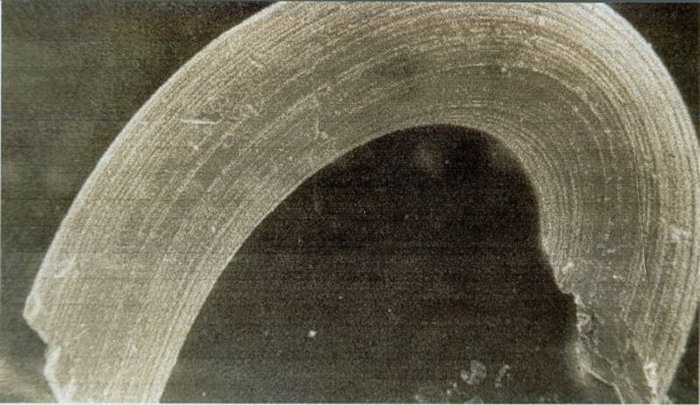Prehistoric Hi-Tech Nanospirals Barely Visible To The Naked Eye: Still Remain An Unsolved Mystery
A.Sutherland - AncientPages.com - Strange microscopically small nanospirals within the material that had to be at least 100,000 years old have been detected in several places, during a routine investigation of mineral deposits in the Ural Mountains in 1992.
The origin of these extraordinary and strange artifacts that the human eye can barely see - is still not explained.
There were many speculations regarding the nanospirals. Some said they are forgery, but alternative history researchers think the artifacts offer proof of advanced ancient high-tech knowledge.
However, the discovery of these prehistoric artifacts is very interesting, because the sophisticated technology required to make this kind of product - only goes back to the 1970s.
The spirals range between 3 cm and 0.0003 mm in size. Their remarkable regularity in structure and smooth surfaces, perforated in places, are only visible under an electron microscope.

The nanospirals are of copper, tungsten or molybdenum. The latter two metals along with others are used in electronics and rocket technology.
The nanospirals are mainly made of tungsten and their cores are tungsten or molybdenum. Ones discovered at a later date were also made of copper.
Fascinating is the spirals' proportion due to their surprising regularity, which indicates that they could only have been manufactured by mechanical means. So one can say their construction is artificial.
Their date of origin is estimated between 300,000 and 100,000 BC.
Written by – A. Sutherland - AncientPages.com Senior Staff Writer
More From Ancient Pages
-
 The Thunder Stone: World’s Largest Monolith Moved By Man
Ancient History Facts | Jun 14, 2018
The Thunder Stone: World’s Largest Monolith Moved By Man
Ancient History Facts | Jun 14, 2018 -
 ‘Incredibly Rare’ Roman Tomb Unearthed Near London Bridge Station
Archaeology | Jun 13, 2023
‘Incredibly Rare’ Roman Tomb Unearthed Near London Bridge Station
Archaeology | Jun 13, 2023 -
 World’s Oldest Paycheck Reveals Ancient Sumerian Workers Were Paid In Beer
Ancient History Facts | Nov 22, 2018
World’s Oldest Paycheck Reveals Ancient Sumerian Workers Were Paid In Beer
Ancient History Facts | Nov 22, 2018 -
 Hieroglyphs Reveal The Name Of Forgotten Maya Queen Ix Ch’ak Ch’een
Archaeology | Nov 21, 2025
Hieroglyphs Reveal The Name Of Forgotten Maya Queen Ix Ch’ak Ch’een
Archaeology | Nov 21, 2025 -
 Vatican Secrets – Dangerous Knowledge And Invention That Could Alter History
Ancient Mysteries | Dec 14, 2018
Vatican Secrets – Dangerous Knowledge And Invention That Could Alter History
Ancient Mysteries | Dec 14, 2018 -
 Petroglyphs Hold Secrets To 14,000 Years Of Human Life In Iran
Archaeology | Apr 30, 2020
Petroglyphs Hold Secrets To 14,000 Years Of Human Life In Iran
Archaeology | Apr 30, 2020 -
 Riddle Of Brazilian Atlantis – Strange Discovered Rocks The World Forgot About
Featured Stories | Jan 28, 2022
Riddle Of Brazilian Atlantis – Strange Discovered Rocks The World Forgot About
Featured Stories | Jan 28, 2022 -
 Rare Preserved Written Account Of North America’s Ancient Lost Civilization Of Tall Beings From An Unknown Land
Featured Stories | Aug 25, 2024
Rare Preserved Written Account Of North America’s Ancient Lost Civilization Of Tall Beings From An Unknown Land
Featured Stories | Aug 25, 2024 -
 On This Day In History: First Battle Of Reading Took Place – On Jan 4, 871 AD
News | Jan 4, 2017
On This Day In History: First Battle Of Reading Took Place – On Jan 4, 871 AD
News | Jan 4, 2017 -
 Persephone: Greek Goddess Of The Coming Spring And Lady Of The Land Of The Dead
Featured Stories | Jun 26, 2021
Persephone: Greek Goddess Of The Coming Spring And Lady Of The Land Of The Dead
Featured Stories | Jun 26, 2021 -
 Immortal Mimi Spirits In Beliefs Of Aborigines Of Arnhem Land
Featured Stories | Mar 26, 2020
Immortal Mimi Spirits In Beliefs Of Aborigines Of Arnhem Land
Featured Stories | Mar 26, 2020 -
 Gigantic Engravings Of A Giraffe Created Long Before Egypt As We Know It Existed
Ancient Mysteries | Jan 14, 2015
Gigantic Engravings Of A Giraffe Created Long Before Egypt As We Know It Existed
Ancient Mysteries | Jan 14, 2015 -
 Tomb Of A 1,000-Year-Old Sican Surgeon Wearing A Golden Mask Discovered In Peru
Archaeology | Mar 30, 2022
Tomb Of A 1,000-Year-Old Sican Surgeon Wearing A Golden Mask Discovered In Peru
Archaeology | Mar 30, 2022 -
 Colors On These Ancient Pots Hint At The Power Of An Empire
Archaeology | Mar 7, 2023
Colors On These Ancient Pots Hint At The Power Of An Empire
Archaeology | Mar 7, 2023 -
 Ancient Nomads You’ve Probably Never Heard Of Disappeared From Europe 1,000 Years ago. Now, DNA Analysis Reveals How They Lived
Featured Stories | Jun 20, 2024
Ancient Nomads You’ve Probably Never Heard Of Disappeared From Europe 1,000 Years ago. Now, DNA Analysis Reveals How They Lived
Featured Stories | Jun 20, 2024 -
 LIDAR Reveals Secrets Of The Enormous Ancient Maya City Of Calakmul
Archaeology | Oct 31, 2022
LIDAR Reveals Secrets Of The Enormous Ancient Maya City Of Calakmul
Archaeology | Oct 31, 2022 -
 How Did People Go To The Toilet In The Past Before The Invention Of The Flush Toilet?
Archaeology | Jun 10, 2023
How Did People Go To The Toilet In The Past Before The Invention Of The Flush Toilet?
Archaeology | Jun 10, 2023 -
 Myth Of The Pale Sun Followed By A Catastrophe Confirmed By Archaeologists
Featured Stories | Sep 22, 2024
Myth Of The Pale Sun Followed By A Catastrophe Confirmed By Archaeologists
Featured Stories | Sep 22, 2024 -
 Londinium: Ancient Roman Outpost That Became Powerful City Of London
Featured Stories | Aug 16, 2018
Londinium: Ancient Roman Outpost That Became Powerful City Of London
Featured Stories | Aug 16, 2018 -
 Hasankeyf – 12,000-Year-Old Mesopotamian City Will Be Destroyed – Decision Sparks Outrage And Controversy
Archaeology | Aug 28, 2019
Hasankeyf – 12,000-Year-Old Mesopotamian City Will Be Destroyed – Decision Sparks Outrage And Controversy
Archaeology | Aug 28, 2019



